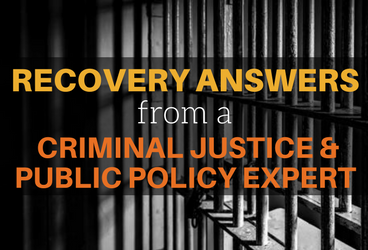
June 26, 2017 |
Addiction & The Criminal Justice System
By Susan Broderick | 2017

Our nation is in the midst of the worst addiction epidemic in our history.
The Centers for Disease Control reports that more than 50,000 Americans died from drug overdoses in both 2015 and 2016, the highest figures ever reported. The unparalleled extent of this crisis was confirmed in Facing Addiction, the groundbreaking report issued by the Surgeon General last November. The Surgeon General reports that over 20.8 million Americans suffer from a substance-use disorder (SUD), and one in seven Americans eventually will face such disorders. To address this crisis, the criminal justice system has been on the front lines, as incarceration often takes the place of formal treatment.
Substance use disorders and the criminal justice system have a long and intertwined history. Drug and alcohol use leads to criminal justice involvement both directly (e.g., possession and sales of illicit substances) and indirectly (e.g., thefts to purchase drugs; vehicle accidents/DUIs). As one of the 13 NIDA Principles of Effective Addiction Treatment, principle number 11 is that treatment does not need to be voluntary to be effective. Lives can be transformed when substance use disorders are addressed, and very often it can be the result of legal consequences. The willingness to make a change in behavior may be spurred by the negative consequences of an arrest.
At the forefront of all this, prosecutors have been playing an increasingly large role. Because most criminal cases are not prosecuted in federal court, state and local prosecutors have been using their role as community leaders to address the addiction crisis across the entire continuum. As powerful gatekeepers to the system, prosecutors make initial charging decisions and determinations that are critical to the outcome of every case, from addressing concerns of supply and demand, to providing a window of opportunity to low-level offenders to participate in mandatory substance use disorder treatment.
While traditionally, most prosecutor’s offices have focused their attention on reducing the supply of drugs through targeting traffickers and dealers, today’s prosecutors are also working to reduce the demand for drugs through innovative prevention, diversion and recovery support initiatives. Prosecutors across the country are now spearheading prevention programs in which they work together with other stakeholders to provide their communities a better understanding of the preventable yet potentially chronic nature of substance use disorders. Strides have been made to treat substance use disorders through drug court models and other innovative policies, and surprisingly to some, the criminal justice system is now the second largest source of referrals to substance use disorder treatment, amounting to approximately 34% of referrals nationally.
In balancing both the public health and public safety considerations of this crisis, well-trained prosecutors can actually ‘raise’ the bottom for those involved in the justice system who are struggling with substance use. The leverage of the law can be used to hold people accountable, while also providing adequate treatment and care. In the end, both the public and the individual benefit.
Unfortunately, treatment & care for substance use disorders is inconsistent across states & extremely underfunded.
More money is needed to increase treatment interventions during incarceration such as access to medication assisted treatments, psychosocial counseling, and peer support groups. Funding is also needed to step up the role of the criminal justice system during other stages as well, such as in prevention and continuing care of substance use disorders.
With substance use disorder prevention, as with other chronic conditions, the earlier the intervention, the better the prognosis. Addressing substance use before it has progressed into a more severe and entrenched problem can be accomplished through the expansion of innovative early intervention and pre-trial diversion programs. This is especially true with regard to adolescents and young adults, who are at increased risk for developing substance use disorders because of vulnerabilities in the developing brain.
In addition to pre-addiction, continuing or ongoing care for individuals after release is needed. For those completing treatment, the period immediately following is often a heightened time for relapse and recidivism. An episodic or 28-day application of treatment is a good beginning for many, but does little to address the chronic nature of the disease. Prosecutors can address this by working with other stakeholders to link ongoing recovery support to anyone completing treatment for a substance-use disorder. While the concept of recovery support is relatively new to the field of criminal justice, it is arguably one of the most effective strategies to reduce recidivism. Preventing relapse for those involved in the justice systems is not only critical to maintaining public safety; but an important step to transforming and saving lives.
The Department of Justice currently has a three-part prevention, enforcement and treatment strategy, but it is not enough. To truly address substance use in a comprehensive manner, the current Attorney General must develop specific federal policy directives and funding initiatives that focus on prioritizing recovery, new training, and technical assistance projects to support front-line professionals, especially prosecutors.
Susan Broderick, J.D., is an Associate Research Professor at Georgetown University and Project Director of the National Juvenile Justice Prosecution Center. She was an Assistant District Attorney in Manhattan, N.Y., from 1989 to 2003.
Editorial Contributions by: Dr. John Kelly & Alexandra Plante

